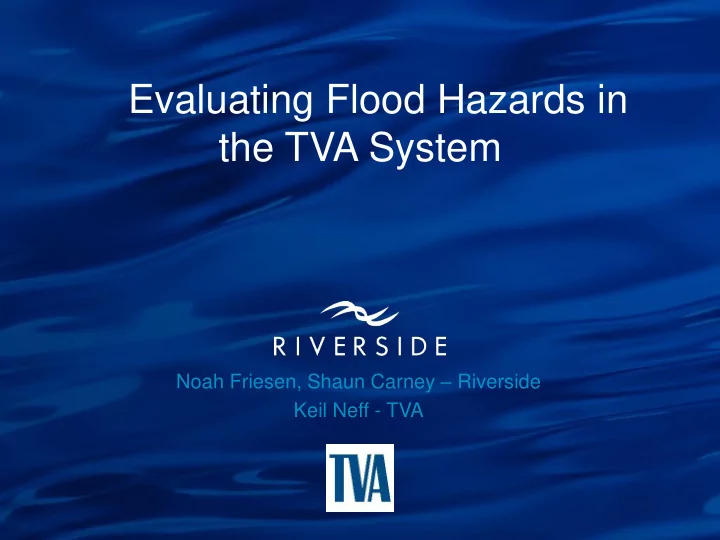

Evaluating Flood Hazards in the TVA System Noah Friesen, Shaun Carney – Riverside Keil Neff - TVA
Tennessee River System
Multipurpose Water Management Goals Navigation Water Supply Provide 652 miles of Maintain levels for >700 • • navigable waterway intakes >$1B/yr economic benefit • Flood-Damage Reduction Recreation Reduce damages Provide suitable levels and • • ~$250M/yr flows for reservoir & rivers $1B/yr economic impact • Draw to the valley • Power Generation Water Quality ~$600M/yr of cheap & • Provide min flows for • clean energy habitat and assimilation Considerable peaking and • Manage temperatures for • ancillary services thermal plants Manage dissolved oxygen •
RiverWare Models - ROS • ROS • Planning model • Built by Riverside in 2003/2004 • Segmented in time and space due to computing limitations
RiverWare Models - Operational • Used currently by TVA • Optimization • Limited functionality for high flows
RiverWare Models – Hydrologic Hazards • Current project • ROS rules (modified) • Operational model structure and objects (modified as needed)
Work Done on Model • Update ROS model from RiverWare version 4.4 to 6.9 • Consolidate segmented ROS model into single new model • Update rules to match current operations • Changes to flood and recovery modes • Simplified some rule logic
Risk Hydrologic Hazards and Risks
Risk • Flood risk across TVA? • Risks affecting multiple projects • System risk reduction alternatives • Stochastic Flood Simulation • Natural hydrologic processes • Reservoir operation • Simulation process is easy to understand and validate – mimics reality • A natural platform to add dam safety risk analysis: • Failure modes, gate reliability, breach modeling and consequences • Inputs to Risk Informed Decision Making
Risk • Determine probabilities for events between historical record and PMF • Prioritize risk reduction efforts effectively What is the likelihood of the PMF? Reasonable certainty for smaller floods How much farther will the spill gates protect?
Stochastic Flood Simulation Approach • Baseline run • 1000 years • Precip record created from actual data • Carefully sampling wet/dry periods maintains realism • Run precip through hydrologic models to get inflows and soil moisture states • Process inflows using RiverWare
Stochastic Flood Simulation Approach Select storm magnitude for storm type • Simulate real storms, Select spatial and temporal storm pattern watershed response, Select date of storm and reservoir system response Select soil moisture state for all sub-basins based on chosen date from time series of soil moisture • Repeat Repeat ten of thousand conditions thousands of times times, compute Select initial reservoir levels for all dams based on chosen date from time series of reservoir statistics from results levels reflecting current reservoir operating policies • Each simulation mimics Conduct hydrologic and reservoir operation response to real events simulations Post-process flood hydrographs and flood outputs to develop hydrologic hazard curves for selected flood characteristic outputs
Stochastic Flood Simulation Approach • Precipitation sampling per simulation 22.0 Extreme Value Type 1 Plotting Paper 20.0 Holston River System - Cherokee Dam 3,425-mi 2 48-HOUR PRECIPITATION (in) 18.0 16.0 14.0 90% Uncertainty Bounds 12.0 10.0 8.0 Mean Frequency Curve 6.0 Best-Estimate 4.0 2.0 0.0 10 -4 10 -6 0.9 0.5 10 -1 10 -2 10 -3 10 -5 10 -7 10 -8 10 -9 ANNUAL EXCEEDANCE PROBABILITY Basin-Average Precipitation 0.50 HOURLY PRECIPITATION (in) 0.40 0.30 0.20 0.10 0.00 0 12 24 36 48 60 72 84 96 108 120 132 144 156 168 ELAPSED TIME (Hours)
Stochastic Flood Simulation Approach • Run SEFM • Developed by MGS Engineering • Sample precip • Run hydrologic models (based on NWS models) • Route flows to reservoirs • Run RiverWare • Analyze results
Stochastic Flood Simulation Approach • Controlled through custom interface • Allows selection of simulation options • Run many many simulations
Stochastic Flood Simulation Approach
Stochastic Flood Simulation Approach
Stochastic Flood Simulation Approach Future Work • Add failure into RiverWare • Gate failure • Blockages • Dam breaches? • Perform risk calculations in RiverWare
Stochastic Flood Simulation Approach • Approach to develop hydrologic hazard curves Hydrologic Hazard Curve - Max Reservoir Level 590 Extreme Value Type 1 Plotting Paper Maximum Reservoir Level (ft) 580 Dam Crest 570 Top Flood Control Pool 560 550 540 Thousands Hydrologic Hazard Curve - Peak Flow 530 180 520 Extreme Value Type 1 Plotting Paper 160 510 Normal Pool Peak Reservoir Inflow (cfs) 140 500 0.99 10 -3 10 -4 10 -6 0.80 0.50 0.10 0.01 10 -5 120 ANNUAL EXCEEDANCE PROBABILITY 100 80 60 40 Hydrologic Hazard Curve - Max Reservoir Discharge Max Reservoir Discharge (cfs) Thousands 20 180 Extreme Value Type 1 Plotting Paper 0 160 0.99 0.80 0.10 0.01 10 -3 10 -4 10 -6 0.50 10 -5 140 ANNUAL EXCEEDANCE PROBABILITY 120 100 80 60 Dam Overtopping 40 Limit of Flood Control Operations 20 0 0.99 10 -3 10 -4 10 -6 0.80 0.50 0.10 0.01 10 -5 ANNUAL EXCEEDANCE PROBABILITY
Stochastic Flood Simulation Approach • Summary of results in standard f- 𝑂 charts
Benefits • Risk-informed decision making • Lower risk to life and property effectively and economically • Easy to understand results – easy to validate • Can be used for future planning studies • Can be used in training for TVA River Operations staff
The End
Recommend
More recommend